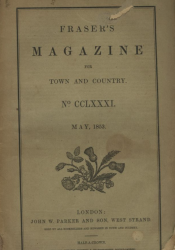Fraser's Magazine and The History of British Newspaper
"Fraser's Magazine for Town and Country" later known as "Longaman's Magazine" was one of the early popular political magazine in London during this time. This newspaper took a "strong line in TORY politics".
Tory poltics being: "a Tory (/ˈtɔːri/) is a person who holds a political philosophy known as Toryism, based on a British version of traditionalism and conservatism, which upholds the supremacy of social order as it has evolved in the English culture throughout history."
During this time, newspapers were the main formof propaganda, a close contender to standing on a soap box and preaching your beliefs to the people. "Fraser's" was created by Hugh Fraser and William Maginn in an effort to be a general and literary magazine for the people. slowly however, "Leaning conservative at first and at last and providing a plethora of material on the press, Fraser's was the child but not the namesake of publisher James. The magazine's unique and usually illustrated mini-biographies called attention to its well-known and unknown personnel." (Palmegiano)
Fraser's magazine however, failed, and was superceded by "Longman's Magazine" which was published by Longman, " none of the oldest publishers in the UK".
As stated before, Newpaper's were very important during this time and in "Middlemarch" we even get to see Ladislaw, and Mr. Brooke work at the local Paper during Brooke's breif political endeavors. The rise of newspapers in England started in the 17th century with such things as small pages about news or gossip. they then later branched out into actual businesses. For example, "The Times" came into publication in 1785 due to the society's relationship to the government and censorship and soon became one of the leading publishers before the paper tax started to rise.
"In 1802 and 1815 the tax on newspapers was increased to three pence and then four pence. Unable or unwilling to pay this fee, between 1831 and 1835 hundreds of untaxed newspapers made their appearance. The political tone of most of them was fiercely revolutionary. Their publishers were prosecuted but this failed to discourage untaxed newspapers. It was chiefly Milner Gibson and Richard Cobden who advocated the case in parliament to first reduce in 1836 and, in 1855, totally repeal the tax on newspapers. The development of the press was greatly assisted by the gradual abolition of the taxes on periodicals as well as by the introduction of a cheap postal system. Both of these developments made the newspaper more affordable to a greater percentage of the population. The burden of the newspaper tax on publishers was heavy, resulting in 29,400,000 tax stamps being issued in 1820. In 1828 the proprietor of The Times had to pay the state more than £68,000 in taxes. After the reduction of the stamp tax in 1836 from four pence to one penny, the circulation"
https://www.thetimes.co.uk/archive/page/1875-08-03/2.html?region=global has achives of all/if not most of the daily times papers that were published during this time. while looking through, you can see the annoucements of new birth, shipping/import schedules, political viewpoints, and etc.
WORKS CITED:
History of British newspapers. (2020, September 26). Retrieved October 07, 2020, from https://en.wikipedia.org/wiki/History_of_British_newspapers
https://www.thetimes.co.uk/archive/article/1875-08-03/1/1.html?region=gl...

